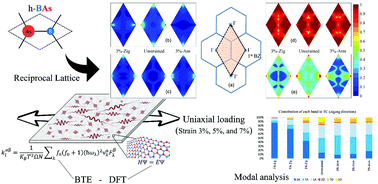Modulated thermal conductivity of 2D hexagonal boron arsenide: a strain engineering study†
Abstract
On-going prediction and synthesis of two-dimensional materials attract remarkable attention to engineer high performance intended devices. Through this, comprehensive and detailed uncovering of the material properties could be accelerated to achieve this goal. Hexagonal boron arsenide (h-BAs), a graphene counterpart, is among the most attractive 2D semiconductors. In this work, our objective is to explore the mechanical, electronic, and thermal properties of h-BAs. We found that this novel 2D material can show a high elastic modulus of 260 GPa, which is independent of the loading direction. We also observed that this system shows a direct and narrow band-gap of 1.0 eV, which is highly desirable for electronic applications. The focus of our investigation is to gain an in-depth understanding of the thermal transport along the monolayer h-BAs and further tune the thermal conductivity by strain engineering. In this regard, the thermal conductivity of a stress-free and pristine monolayer was predicted to be 180.2 W m−1 K−1, which can be substantially enhanced to 375.0 W m−1 K−1 and 406.2 W m−1 K−1, with only 3% straining along the armchair and zigzag directions, respectively. The underlying mechanism for such a remarkable boosting of thermal conductivity in h-BAs was correlated to the fact that stretching makes the flexural out-of-plane mode the dominant heat carrier. Our results not only improve the understanding concerning the heat transfer in h-BAs nanosheets but also offer possible new routes to drastically improve the thermal conductivity, which can play critical roles in thermal management systems.



 Please wait while we load your content...
Please wait while we load your content...